- Home
- Jared Diamond
The Rise and Fall of the Third Chimpanzee Page 16
The Rise and Fall of the Third Chimpanzee Read online
Page 16
As our third example, let’s compare males and females of the same species. We expect more potential payoff from repair mechanisms, and lower rates of aging, in that sex with the lower accidental mortality rate. For many or most species, males suffer greater accidental mortality than females, partly because males put themselves at greater risk by fighting and bold displays. This is certainly true of human males today and has probably been so throughout our history as a species – men are the sex most likely to die in wars against men of other groups, and in individual fights within a group. Also, in many species the males are bigger than the females, but studies of red deer and of New World blackbirds show that males are thereby more likely than females to die when food becomes scarce.
Correlated with this greater accidental death rate of men, men also age faster and have a higher non-accidental death rate than women. At present, women’s life expectancy is about six years greater than that of men; some of this difference is because more men than women are smokers, but there is a sex-linked difference in life expectancy even among non-smokers. These differences suggest that evolution has programmed us so that women put more energy into self-repair, while men put more energy into fighting. Expressed another way, it just is not worth as much to repair a man as it is to repair a woman. I do not thereby mean to denigrate male fighting, which serves a useful evolutionary purpose for a man: to gain wives and to secure resources for his children and his tribe, at the expense of other men and their children and tribe.
*
My remaining example of how some striking facts of aging become comprehensible only from an evolutionary perspective concerns the distinctively human phenomenon of survival past reproductive age, especially past female menopause. Since transmitting one’s genes to the next generation is what drives evolution, other animal species rarely survive past reproductive age. Instead, Nature programmes death to coincide with the end of fertility, because there is then no longer an evolutionary benefit to gain from keeping one’s body in good repair. It is an exception in need of explanation to realize that women are programmed to live for decades after menopause, and that men are programmed to live to an age when most men are no longer busy siring babies.
But the explanation becomes apparent on reflection. The intense phase of parental care is unusually protracted in the human species and lasts nearly two decades. Even those older people whose own children have reached adulthood are tremendously important to the survival of not just their children but of their whole tribe. Especially in the days before writing, they acted as the carriers of essential knowledge. Thus, Nature has programmed us with the capacity to keep the rest of our bodies in reasonable repair even at an age when the female reproductive system itself has fallen into disrepair.
Conversely, though, we have to wonder why natural selection programmed female menopause into us in the first place. It too, like aging, cannot be explained away as something physiologically inevitable. Most mammals, including human males plus chimps and gorillas of both sexes, merely experience a gradual decline and eventual cessation of fertility with age, rather than the abrupt shutdown of women’s fertility. Why did that peculiar, seemingly counter-productive feature of ours evolve? Would not natural selection favour the woman who remained fertile until the bitter end?
Human female menopause probably resulted from two other distinctively human characteristics: the exceptional danger that childbirth poses to the mother, and the danger that a mother’s death poses to her offspring. Recall from Chapter Three the enormous size of the human infant at birth relative to its mother: our big 7-pound babies emerging from 100-pound mothers, compared to little 4-pound gorilla babies emerging from a 200-pound gorilla mother. As a result, childbirth is dangerous to women. Especially before the advent of modern obstetrics, women often died in childbirth, whereas mother gorillas and chimps virtually never do.
Now recall also from Chapter Three the extreme dependence of human infants on their parents, especially on their mother. Because human infants develop so slowly and cannot even feed themselves after weaning (unlike young apes), the death of a hunter-gatherer mother would have been likely to be fatal to her offspring up to a later age in childhood than for any other primate. Hence a hunter-gatherer mother with several children was gambling the lives of those children at every subsequent childbirth. Since her investment in those prior children increased with their age, and since her own risk of death in childbirth also increased with her age, the odds of her gamble paying off got worse and worse as she got older. When you already have three children alive but still dependent on you, why risk those three for a fourth?
Those worsening odds probably led through natural selection to menopausal shutdown of human female fertility, in order to protect a mother’s prior investment in children. Since childbirth carries no risk of death for fathers, men did not evolve menopause. Like aging, menopause illustrates how an evolutionary approach illuminates features of our life-cycle that would otherwise be counter-intuitive. It is even possible that menopause evolved only within the past 40,000 years, when Cro-Magnons and other anatomically modern humans began frequently to survive to the age of sixty or more. Neanderthals and earlier humans usually died before the age of forty anyway, so that menopause would have brought their women no benefits if it were to occur at the same age as in modern Femina sapiens.
Thus, the longer lifespan of modern humans than of apes rests not only on cultural adaptations, such as tools to acquire food and deter predators. It also rests on the biological adaptations of menopause and increased investment in self-repair. Whether those biological adaptations developed especially at the time of the Great Leap Forward or earlier, they rank among the life history changes that permitted the rise of the third chimpanzee to humanity.
*
The last conclusion that I wish to draw from an evolutionary approach to aging is that it undermines the approach which has long dominated the physiological study of aging. The gerontological literature is obsessed with a search for The Cause of Aging – preferably a single cause, certainly not more than a few major causes. Within my own lifetime as a biologist, hormonal changes, deterioration in the immune system, and neural degeneration have vied in popularity for the title of The Cause, without compelling support having been adduced to date for any of the candidates. But evolutionary reasoning suggests that this search will remain futile. There should not be just one, or even a few, dominant physiological mechanisms of aging. Instead, natural selection should act to match rates of aging in all physiological systems, with the result that aging involves innumerable simultaneous changes.
The basis of this prediction is as follows. There is no point doing expensive maintenance on one piece of the body if other pieces are deteriorating more rapidly. Conversely, natural selection should not permit a few systems to deteriorate long before all the others, as the cost of extra repairs on just those few systems would then buy a big increase in life expectancy and would be worth it. By analogy, Mercedes-owners should not install cheap ball-bearings when they are lavishing expense on all other parts of the car. Had they been so foolish, they could have doubled the lifetime of their costly car just by spending a few more dollars for better ball-bearings. But it would not pay either to go to the expense of installing diamond ball-bearings, when all the rest of the car would have rusted away before those ball-bearings wore out. Thus, the optimal strategy for Mercedes-owners, and for us, is to repair all parts of our cars or bodies at such rates that everything finally collapses all at once.
It seems to me that this depressing prediction is borne out, and that we come closer to this evolutionary ideal than to the physiologists’ long-sought Cause of Aging. Signs of aging can be found wherever one looks for them. Already I am conscious in myself of tooth wear, considerable decreases in muscle performance, and significant losses in hearing, vision, smell, and taste. For all these senses, the acuity of women is greater than that of men of equal age, whatever the age group compared. Ahead of me lies the fa
miliar litany: weakening of the heart, hardening of the arteries, increasing brittleness of bones, decreases in kidney filtration rates, lower resistance of the immune system, and loss of memory. The list could be extended almost indefinitely. Evolution seems indeed to have arranged things so that all our systems deteriorate, and that we invest in repair only as much as we are worth.
From a practical standpoint, this conclusion is disappointing. If there had been one dominant cause of aging, curing that cause would have provided us with a fountain of youth. This thought, operating at a time when aging was thought to be largely a hormonal phenomenon, inspired some attempts at miraculous rejuvenation of old people by hormonal injections or implantation of young gonads. Such an attempt was the subject of Sir Arthur Conan Doyle’s story, The Adventure of the Creeping Man, in which the aged Professor Presbury becomes infatuated with a young woman, desperately wants to rejuvenate himself, and instead is found creeping around like a monkey after midnight. The great Sherlock Holmes discovers the reason: the Professor has been seeking youth by injecting himself with the serum of langur monkeys.
I could have warned Professor Presbury that his myopic obsession with proximate causation would lead him astray. Had he thought of ultimate evolutionary causation, he would have realized that natural selection would never permit us to deteriorate through a single mechanism with one simple cure. Perhaps it is just as well. Sherlock Holmes worried greatly about what would happen if such an elixir of life were found:
There is danger there – a very real danger to humanity. Consider, Watson, that the material, the sensual, the worldly would all prolong their worthless lives … It would be the survival of the least fit. What sort of cesspool may not our poor world become?
Holmes would be relieved to know that his worries now appear unlikely to materialize.
PART THREE
UNIQUELY HUMAN
PARTS ONE AND two discussed the genetically specified foundations of our unique cultural traits. We saw that those foundations include our familiar skeletal hallmarks, such as our large braincase and our adaptations for upright gait. They also include features of our soft tissues, behaviour, and endocrinology concerned with reproduction and social organization.
But if those genetically specified features were our sole distinctions, we would not stand out among animals, and we would not now be threatening the survival of ourselves and other species. Other animals, such as ostriches, walk erect on two legs. Others have relatively large brains, though not as large as ours. Others live monogamously in colonies (many seabirds), or are very long-lived (albatrosses and tortoises).
Instead, our uniqueness lies in the cultural traits that rest on those genetic foundations and that in turn give us our power. Our cultural hallmarks include spoken language, art, tool-based technology, and agriculture. But if we stopped there, we would have a one-sided and self-congratulatory view of our uniqueness. The hallmarks I just mentioned are ones that we are proud of. Yet the archaeological record shows the introduction of agriculture to have been a mixed blessing, seriously harming many people while benefitting others. Chemical abuse is a wholly ugly human hallmark. At least it does not threaten our survival, as do two of our other cultural practices: genocide, and mass exterminations of other species. We are uncomfortable about whether to regard these as occasional pathological aberrations, or as features no less basic to humanity than the traits we are proudest of.
All of these cultural traits that define humanity are seemingly absent in animals, even in our closest relatives. They must have arisen some time after our ancestors parted company from the other chimpanzees around seven million years ago. Furthermore, while we have no way of knowing whether Neanderthals spoke or indulged in drug abuse and genocide, they certainly did not have agriculture, art, or the capacity to build radios. These latter traits must therefore be very recent human innovations of the last few tens of thousands of years. However they could not have arisen from nothing. There had to have been animal precursors, if we could only recognize them.
For each of our defining cultural traits, we need to ask, what were those precursors? When in our ancestry did the trait approach its modern form? What were the early stages of its evolution like, and can those stages be traced archaeologically? We are unique on Earth, but how unique are we in the universe?
Our two most dangerous traits, genocide and environmental destruction, will be reserved for discussion in Parts Four and Five. Here we will consider some of the above-mentioned questions for our noble, two-edged, or only mildly destructive characteristics. Chapter Eight takes up the origin of spoken language, which I suggested in Chapter Two might have triggered the Great Leap Forward, and which anyone would list among our most important distinctions from animals. On first reflection, the task of tracing the development of human language appears plainly impossible. Language before the dawn of writing left no archaeological remains, unlike our first experiments in art, agriculture, and tools. There seems to be no surviving simple human language, no animal language, that could exemplify the early stages.
In fact, there are innumerable animal precursors: the vocal communication systems evolved by many species. We are just beginning to appreciate the sophistication of some of these systems. We shall also see that there really are some simple languages that modern humans have unconsciously invented and that prove unexpectedly instructive. Taken together, these complex animal ‘languages’ and simple human languages begin to bridge, from both sides, the apparent chasm with respect to speech between animals and ourselves.
Chapter Nine turns to the origin of art, the noblest human invention. There seems to be a gulf separating human art, supposedly created just for pleasure and doing nothing to perpetuate our genes, from any animal behaviour. Yet paintings and drawings created by captive apes and elephants, whatever the motives of those animal artists, look so similar to work of human artists that they have fooled experts and have been bought by art collectors. If one nevertheless dismisses those animal artworks as unnatural productions, what is one to say about the carefully arranged coloured displays of normal male bowerbirds? Those bowers play an unquestioned crucial role in passing on genes. I shall argue that human art also had that role originally, and often still does today. Since art, unlike language, does show up in archaeological deposits, we know that human art did not proliferate until the time of the Great Leap Forward.
Agriculture, the subject of Chapter Ten, has an animal precedent, but not precursor, in the gardens of leaf-hopper ants, which lie far off from our direct lineage. The archaeological record lets us date our ‘reinvention’ of agriculture to a time long after the Great Leap Forward, within the last 10,000 years. That transition from hunting and gathering to agriculture is generally considered a decisive step in our progress, when we at last acquired the stable food supply and leisure time prerequisite to the great accomplishments of modern civilization. In fact, careful examination of that transition suggests another conclusion: for most people the transition brought infectious diseases, malnutrition, and a shorter lifespan. For human society in general it worsened the relative lot of women and introduced class-based inequality. More than any other milestone along the path from chimpanzeehood to humanity, agriculture inextricably combines causes of our rise and our fall.
Abuse of toxic chemicals is a widespread human hallmark documented only within the last 5,000 years, though it may well go back much earlier into pre-agricultural times. Unlike agriculture, it does not even rank as a mixed blessing but as a pure evil threatening the survival of individuals, though not of our species. Like art, drug abuse seems at first to lack animal precedents or biological functions. I shall argue in Chapter Eleven, however, that it fits into a broad class of animal structures or behaviours that are dangerous to their owners or practitioners, and whose function depends paradoxically on that danger.
While animal precursors can thus be identified for all of our hallmarks, they still rank as human hallmarks because we are unique on Earth in the extr
eme degree to which we have developed them. How unique are we in the universe? Once conditions suitable for life exist on a planet, how likely are intelligent, technologically advanced life forms to evolve? Was their emergence on Earth practically inevitable, and do they now exist on innumerable planets circling other stars?
There is no direct way to prove whether creatures capable of language, art, agriculture, or drug abuse exist elsewhere in the universe, because from Earth we could not detect the existence of those traits on planets of other stars. However, we might be able to detect high technology elsewhere in the universe if it included our own capacity to send out space probes and interstellar electromagnetic signals. In Chapter Twelve I shall examine the on-going search for extraterrestrial intelligent life. I shall argue that evidence from a quite different field – studies of woodpecker evolution on Earth – instructs us about the inevitability of evolving intelligent life, and hence about our uniqueness, not only on Earth but also in the accessible universe.

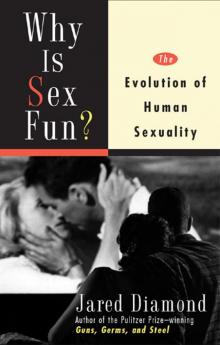 Why Is Sex Fun?: The Evolution of Human Sexuality
Why Is Sex Fun?: The Evolution of Human Sexuality Guns, Germs, and Steel: The Fates of Human Societies
Guns, Germs, and Steel: The Fates of Human Societies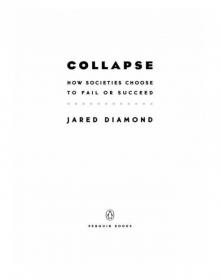 Collapse: How Societies Choose to Fail or Succeed
Collapse: How Societies Choose to Fail or Succeed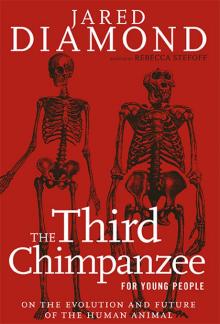 The Third Chimpanzee: The Evolution and Future of the Human Animal
The Third Chimpanzee: The Evolution and Future of the Human Animal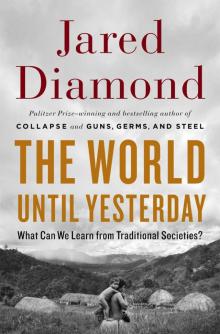 The World Until Yesterday: What Can We Learn From Traditional Societies?
The World Until Yesterday: What Can We Learn From Traditional Societies?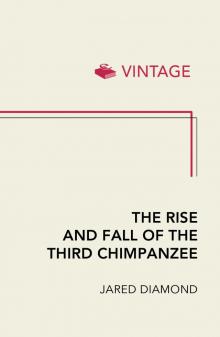 The Rise and Fall of the Third Chimpanzee
The Rise and Fall of the Third Chimpanzee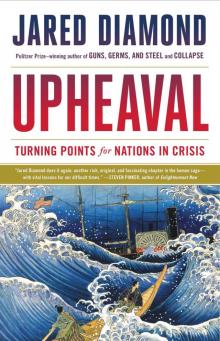 Upheaval: Turning Points for Nations in Crisis
Upheaval: Turning Points for Nations in Crisis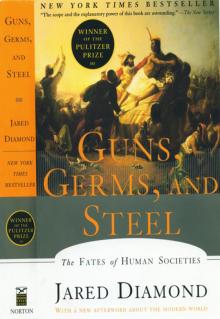 Guns, Germs, and Steel
Guns, Germs, and Steel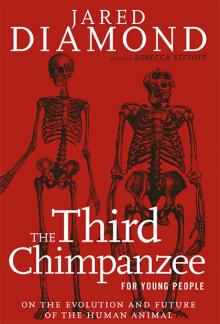 The Third Chimpanzee for Young People
The Third Chimpanzee for Young People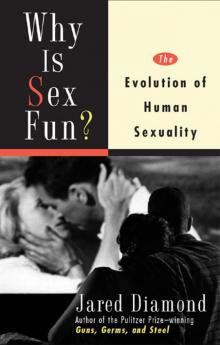 Why Is Sex Fun?
Why Is Sex Fun?